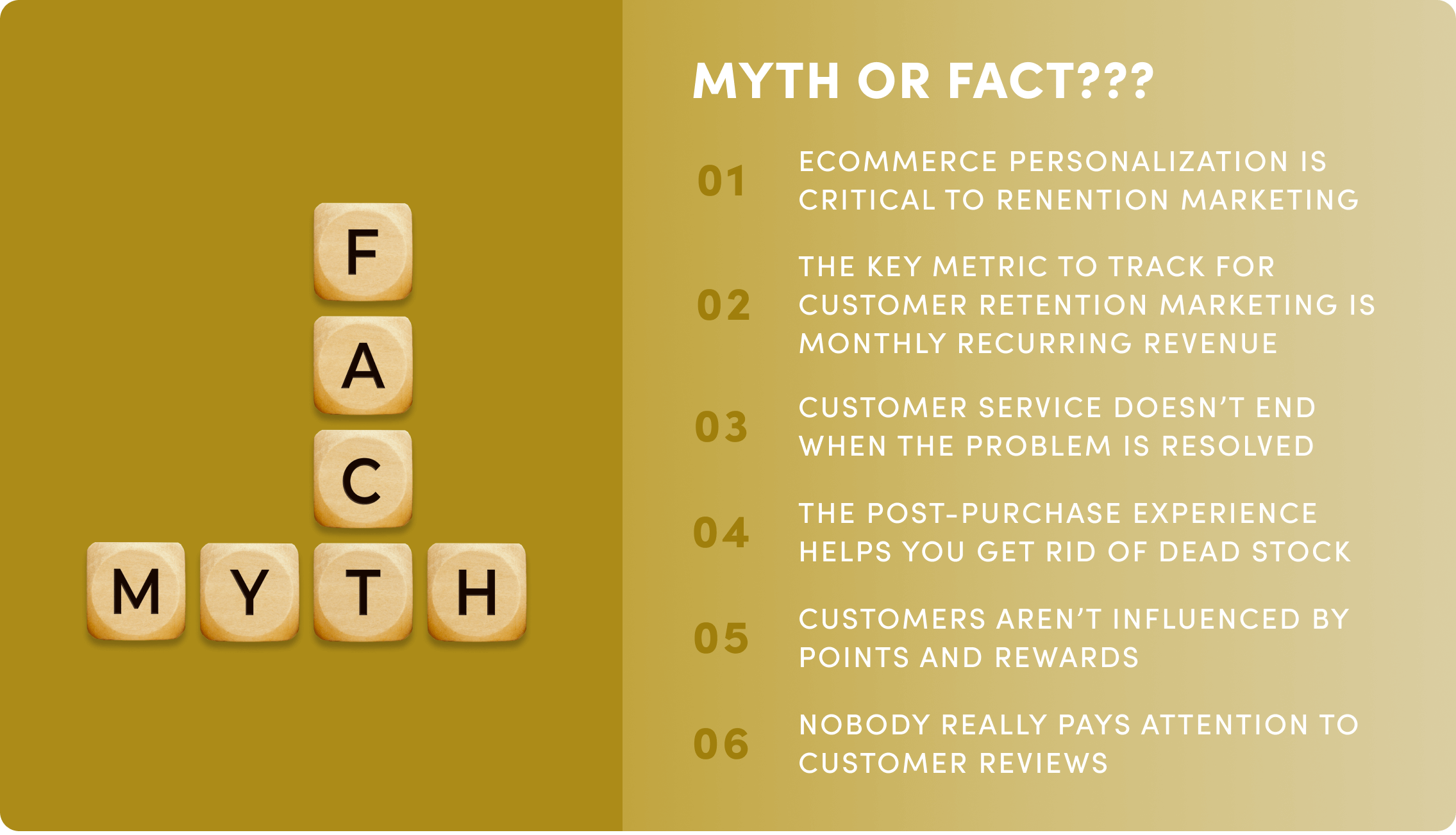Customer retention is five times more cost-effective than acquiring new customers.
.webp?width=980&height=653&name=Manager%20(1).webp)
View retention as a key revenue booster for businesses. By keeping existing customers happy, you not only reduce customer acquisition costs but also increase overall profitability through higher average order values and loyal customer return rates.
That makes investing in customer retention marketing a no-brainer.
Retention marketing helps maintain existing customers who provide a predictable revenue stream and valuable feedback. The hope is that satisfied repeat customers will become brand advocates, promoting your business and attracting new customers through word-of-mouth and referrals.
There are many misconceptions out there about what makes an effective customer retention marketing strategy. So before you dive into the nuts and bolts of customer retention strategy and tactics, let’s bust the myths and unearth the facts so you can set your business up for retention success.

1. Myth or Fact: Ecommerce Personalization Is Critical to Retention Marketing
Answer: FACT
In real estate, it’s “location, location, location.” In ecommerce, it’s “personalization, personalization, personalization.” (Say that five times fast.)
Ecommerce personalization tailors the shopping experience to your customers. This level of personalization boosts the likelihood of customer satisfaction, so they’re more likely to return. But to effectively personalize your marketing efforts, you need to know what your current customers want and the types of messaging that will resonate most.
Gathering and analyzing customer data and behavior are good places to start. Say you’re tracking the products and pages a customer visits. Maybe they’ve added a bunch of items to the cart but then decided to remove one or two to keep costs low. Your next marketing move could be to offer them a discount on the items they removed.
Another strategy is to analyze the performance of email campaigns. What language, content, offers, and cadence work best? You can then use that data to inform future email marketing, push notifications, or other content marketing like social media or blogs for specific customers and customer segments.
2. Myth or Fact: The Key Metric to Track for Customer Retention Marketing Is Monthly Recurring Revenue
Answer: MYTH
If only there was just one thing to track these days. Unfortunately, it’s not that simple. MRR (monthly recurring revenue) is important, but you need more than just one metric to gauge your customer retention marketing efforts.
No one metric is going to give you a complete picture. MRR will show you how much you’re making from subscribers, but it won't reveal which of your customers contribute to that number, how much customers spend per order, or what products are performing best. But if you also look at metrics like customer retention rate (CRR), repeat purchases, or customer feedback scores, you'll have a complete picture.
For example, say your marketing team sends out email notifications to address abandoned carts, recommend related products (cross-selling), request feedback, and announce special promotions. The following metrics will help you determine if your email marketing campaigns are effective:
- Average order value (AOV): The average amount spent each time a customer places an order indicates how successful your upselling and cross-selling strategies are in increasing revenue.
- Net Promoter Score (NPS): Asking customers how likely they are to recommend your business to others is a strong indicator of overall customer satisfaction and loyalty.
- Customer engagement score: The level of engagement and interaction a customer has with your brand shows how appealing or convincing your email and marketing communications are to them.
- Cart abandonment rate: A lower rate tells you that your reminder notifications are working and converting customers.
By regularly tracking these metrics, you gain valuable insights into customer behavior and identify areas for improvement in your retention tactics.
.jpg?width=5472&height=3134&name=facts-myths-concept-2023-11-27-05-18-34-utc%20(1).jpg)
3. Myth or Fact: Customer Service Ends When the Problem Is Resolved
Answer: MYTH
Really good customer service isn’t just about putting out fires.
A great customer service team goes above and beyond just working their way through a queue of customer support requests. To really build strong customer relationships, bring your customer service team into your marketing strategy. Your support team should anticipate customer needs, be proactive with follow-ups, and check in with customers periodically, even when everything seems to be running smoothly.
The customer service team doesn't have to be in every marketing meeting, but there are some approaches you should take to keep them in the loop:
- Share behavioral data with your customer service team to give them more context when they’re speaking to consumers.
- Have customer support team members participate in social media listening and engage when customers voice concerns or ask technical questions.
- Provide the customer service team with ideas to personalize messages and engage customers.
- Encourage the support team to request feedback and funnel it to both departments.
Most importantly, your customer support team must remember that they are the human voice of your brand. How they communicate with customers will directly impact your retention rate.
4. Myth or Fact: The Post-Purchase Experience Helps You Get Rid of Dead Stock
Answer: FACT
Gotta love purging those items collecting dust. Marie Kondo it, amiright?
Dead stock results from items becoming outdated, a limited variety of specific items, or a competitor outselling you on a similar product. With the right post-purchase strategy, such as upselling and cross-selling, you can get rid of products that are taking up unnecessary space.
An effective post-purchase customer experience grabs the shopper’s attention before they even close their browser window. Sending personalized recommendations or special offers through exit intent popups, post-purchase offers, or push notifications incentivizes your shopper to stay on the page longer and consider the opportunity you present them. This might lead to a successful upsell, a subscription sign-up, or the use of a discount code to complete a purchase.

When it comes to getting rid of dead stock, these post-purchase moments are key. For example, say a customer has just purchased a sweater from your ecommerce store, and you have a matching hat that is no longer selling well. There are a few ways you can upsell so you get rid of the excess inventory:
- Place a popup message at checkout that offers an incentive to “complete the look” for a discounted price.
- Send a follow-up email with the order and tracking information, plus a special offer to get a free gift (the hat!) with their next purchase.
- Trigger a push notification that offers the hat as part of a bundle of new products they might like.
Prioritizing the post-purchase experience means finding ways to further delight your customers with great offers while gaining control over your business.
5. Myth or Fact: Customers Aren’t Influenced by Points and Rewards
Answer: MYTH
Most people love free stuff, right? Well, the easiest way to get free stuff is through points and rewards.
According to a U.S. consumer trends report from Marigold, points and rewards are the second-most desired feature of loyalty programs.
Points and rewards don’t only have to be awarded to loyal shoppers. Offer them to customers as an incentive in a referral program. Even your most loyal customers might not immediately spread the word about how great your brand is. That’s why you need to develop a good system to show your appreciation for their loyalty and brand advocacy.
Just like any other marketing strategy, effective loyalty and referral programs use persuasive and engaging tactics. To run a successful program, create a detailed plan that involves things like:
- A branded points system: Customers will be motivated to earn more points when shopping with you so they can use them toward a reward.
- Tiered rewards: This motivates customers to earn more badges so they can level up and earn better rewards.
- Personalized member exclusive offers: Based on their purchase history, send customers special discounts, bonus star opportunities, or priority access to a new product launch.
- Birthday or anniversary rewards: To make loyal customers feel extra special, ship a free item on their birthday or the one-year anniversary of their loyalty membership.
6. Myth or Fact: Nobody Really Pays Attention to Customer Reviews
Answer: MYTH
Reading reviews is as entertaining as it is informative. Good, bad, funny, mad — it’s like a reality show confessional!
Your customer base wants to know they can trust you. One way they do that is by turning to your previous customers. Most people don’t want to spend money on a brand that won’t live up to their expectations. That’s why nearly 55% of online shoppers read a minimum of four reviews before making a purchase.
Customer reviews are a form of social proof that builds trust. Display reviews on product pages, social media, emails, and your home page as part of your retention marketing strategy to increase the likelihood of turning shoppers into returning customers.
One way to get reviews is to send customers a request a few days after their order has arrived. This gives them time to try out the product and provide an honest opinion about how they feel.
It’s key that you accept both positive and negative feedback and reviews. In fact, having a few negative reviews can help build even more trust as it gives your brand credibility. When not all reviews are positive, readers can worry less about being deceived by fabricated reviews.
Bonus Points: If You’re Not Using a Modern Shopping Cart, You’re Leaving Money on the Table
Answer: TRUE FACT!
The numbers speak for themselves. The Rebuy Smart Cart, a cutting-edge modern shopping cart, has been shown to boost subscriptions by an average of 25 to 30%, and collectively generates over $3M in daily revenue for Rebuy customers.
An intelligent shopping cart isn’t just a place for your shoppers to tally up their items. It’s your sidekick. The hero that helps you reduce customer churn and outperform a basic cart every time.
Smart Cart offers AI-powered personalization, automation, and integration with relevant apps. So take your customer retention strategies up a notch and incorporate a modern shopping cart that keeps tabs on every step of the customer journey. You’re already taking steps to improve your retention marketing campaigns. Why not join over 3,000 savvy brands already using Rebuy Smart Cart and see how it improves your retention results along the way?
•••
Try Rebuy free and see why the world’s top brands use Rebuy to accelerate sales growth.
Interested in partnering with Rebuy? Let's do it.
To keep up with the latest trends, platform updates, and more, follow us on LinkedIn.
